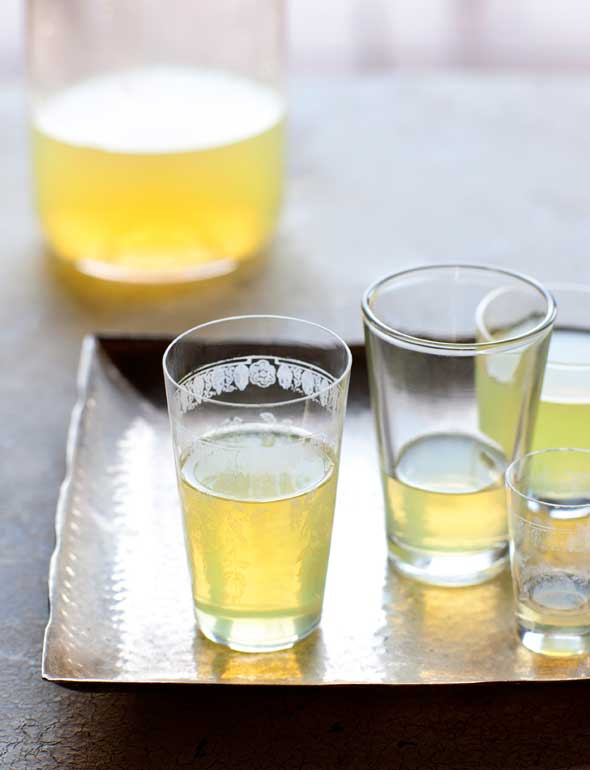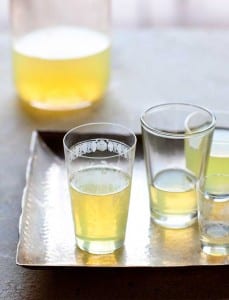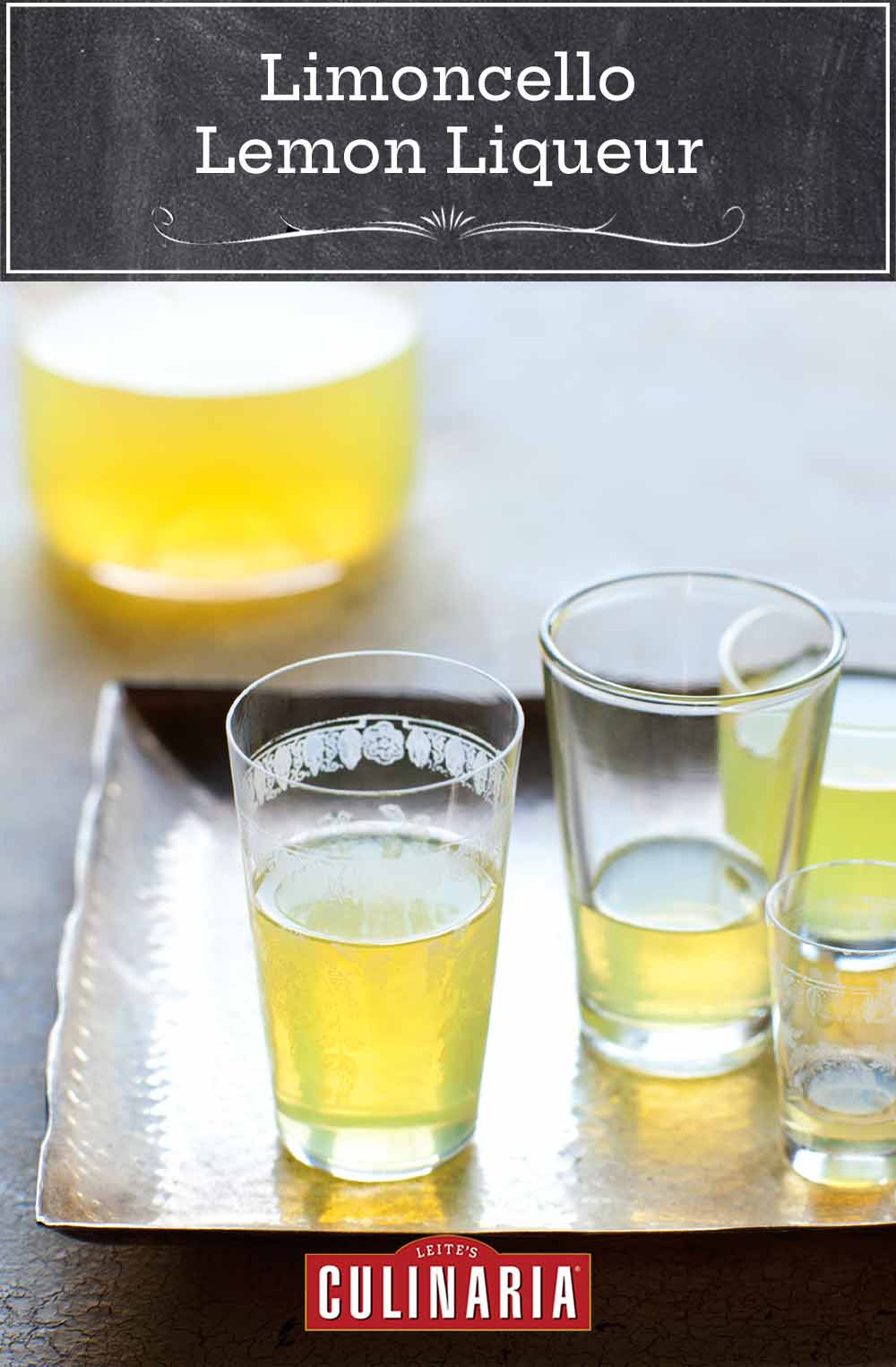
Limoncello is made in homes all over Southern Italy, where lemon trees grow in abundance. Less familiar outside Southern Italy is rosolio di limone, a digestivo, or after-dinner drink. Both rosolio and limoncello are served cold; once you’ve opened a bottle, store it in the refrigerator or freezer. The alcohol will prevent it from freezing solid. Here in California, I use Meyer lemons from my garden, but you can use any variety. Look for lemons that haven’t been sprayed or waxed, the fresher the better.–Rosetta Costantino and Jennie Schacht
LC Lousy With Limoncello Note
As one of our recipe testers noted, until now, we’d always dispensed our limoncello in stingy pours so as not to demolish our precious stash too quickly. But knowing we can make our own changes that. Given that it’s made with 151-proof hooch, we’re not so certain that’s a good thing. Gulp.

Limoncello ~ Lemon Liqueur
Ingredients
- 2 pounds lemons (about 8), preferably organic
- One (26-ounce) bottle 151-proof neutral grain spirits, such as Everclear or vodka
- 2 cups granulated sugar
- 4 cups cold water
Instructions
- Remove the zest from the lemons in wide strips with a vegetable peeler, taking only the yellow part and carefully avoiding even the slightest bit of underlying white pith, which would turn the limoncello bitter. Reserve the zested lemons for another use.
- Pour the alcohol into a clean quart (1-liter) jar with a tight-fitting lid, such as a European-style canning jar with a rubber gasket and clamp lid. Add the lemon zest, close the jar, and let it steep in a cool, dark place, such as a pantry or cellar, for 1 week.
- After the alcohol has steeped for 1 week, stir the sugar and water together in a large saucepan over low heat until the sugar dissolves completely. The mixture should be clear. Remove from the heat and let cool completely. (Do not be tempted to rush into the next step; if the sugar syrup is not completely cool, your limoncello will be cloudy.)
- Remove the lemon zest from the alcohol and discard. Pour the infused alcohol into the sugar syrup and stir to combine. Pour the mixture through a fine-mesh strainer lined with cheesecloth, then decant the limoncello into clean bottles and seal with a cork or lid of some sort.
- Let the limoncello mature for 15 days in a cool, dark place, then refrigerate. Serve chilled.
Notes
Limoncello ~ Lemon Liqueur Variation
Rosolio Di Limone For a sweeter, less puckier (oh, you know what we mean) version of limoncello called rosolio di limone, follow the instructions above, but instead use 6 cups water and 4 cups (800 g) sugar in place of the stated 4 cups water and 2 cups sugar. Let the liqueur sit for the same amount of time.
Nutrition
Nutrition information is automatically calculated, so should only be used as an approximation.
Recipe Testers’ Reviews
Who knew it was so easy to make your own liqueur? I made the limoncello recipe, and I found this to be a little less bitter than some of the limoncello I’ve bought. The process is very simple. It’s just the waiting that’s hard. I like limoncello by itself as an after-dinner drink, and I also spike lemonade with it. I want to try this recipe with other citrus when they’re in season.
I’ve never made an infused vodka before, and I found the process to make the rosolio di limone fascinating. I didn’t have a chance to get to the liquor store to pick up Everclear, so I used vodka. I admit I used the cheap vodka I had on hand, and we love the result. The rosolio, after a full three weeks of aging is sweet, tart, and slightly bitter (in a good way) lemon goodness. I might just love the aroma more than the flavor, but my husband is a true fan. I’m already thinking up recipes we can use it in.
I made the limoncello variation of this recipe. I used 2 pounds organic lemons from Trader Joe’s, which were quite small. (I’ve found bigger lemons are harder to peel.) I definitely recommend using organic lemons, since you’re using the zest. The instructions are very well-written, and my limoncello came out perfectly clear and lemony yellow. The proportions are a little different than the classic Mario Batali recipe, and the finished product has a little less “pow” than I’m used to, but it’s a refreshing after-dinner drink. And, if you bottle it nicely, you can give it as gifts for the holidays, which is exactly what I plan to do. I’ve made limoncello before and have learned a few tips the hard way. A word to the wise:
1. Make sure you get every bit of pith off the zest. I scrape it off with a paring knife. (I know people who use a microplane grater to get just the zest. The pith makes the limoncello come out a shocking yellow-green AND taste like cough medicine.
2. If you’ve been so foolish as to use good-quality vodka AND didn’t get all the pith off, you’re literally throwing money down the drain. It will be undrinkable, and you’ll be deeply discouraged.
3. In any event, high-quality vodka is really not necessary. I used Fleischmann’s, which is half the price of Absolut.
I’m so glad I tried making this rosolio di limone recipe! It was so easy, and the results are wonderful. Hands-on time was very quick, and there was very little mess. It was fun checking the alcohol and the lemon zest after a week of steeping and finding how beautiful the aroma was from the lemon zest. I tried a tablespoon of the liqueur before putting it into sterilized bottles to mature for a couple weeks. Let me tell you, I can’t wait to have a glass during a relaxing moment! It’s so beautifully smooth, perfectly sweet, and has a wonderfully fresh lemon flavor. I used a high-end vodka that I happened to have on hand. This recipe is definitely a keeper!
After a summer filled with my neighbor’s homemade limoncello, I jumped at the chance to make my own. My husband, who was initially distrustful of the concoction, soon became enamored with it. Not only is it delicious, but it has the unique ability to make my husband more enjoyable in social settings. It’s a wonderful after-dinner drink best served with with friends, cigars, and a bonfire. I’d never had Everclear before this. I’ve always considered it in the same category as boxed wine or malt beverages (in other words, I made my husband go to the store and buy it for me). The truth is, the Everclear makes for a very clean-tasting and refreshing drink. Making the limoncello was quite simple. I poured the Everclear into a large glass jar and the lemon strips actually look rather nice floating around. It’s impressive how much flavor and color comes from the zest. (Per my friend’s advice, I juiced the lemons at the same time and saved the juice for other uses.) After one week, I made the simple syrup, cooled it, combined everything, and strained the mixture into sterilized bottles. Considering the staggering amount of alcohol in the Everclear, sterilizing the bottles was probably unnecessary, but one can’t be too careful. We enjoy the limoncello straight out of the freezer. I’ve also used it as a glaze for a lemon pound cake and have spiked sparkling water with it. Now that I have my own private reserve, we don’t have to ration it like we have been. I’m definitely making more to give away for Christmas this year. I wonder if it’s an appropriate teacher gift?
I must admit, I’m not a big fan of limoncello, but this liqueur isn’t overly sweet, it’s easy to make, and delicious. I could easily see using this at any dinner party or just an evening at home. I used organic lemons and, since I really don’t like using grain alcohol, I opted for a bottle of Finlandia vodka. After making sure there was absolutely no white pith on the rinds, I allowed the lemon-infused vodka to sit for a little over a week as required, and then sit around for an additional 15 days with the sugar syrup added. Then I put a small bottle of it into the fridge to get cold enough to sample. Delightful. This is going to make some awesome gifts for the holidays.













A few days after adding the sugar syrup, which was cool, my limoncello started to get weird near top, cloudy whitish looking. It has been very warm here. Is it ruined??
Kathy, there is so much alcohol in this, I don’t think it’s gone bad. Can you keep it in a cool place? And is the cloudiness getting more pronounced?
Yes! There is condensation!! So it’s still good? It tastes wonderful! Should I keep in the fridge? Right now it’s in a dark cupboard, but it is kinda warm. SoCal.
It’s still good, Kathy. Shake it and place it in the fridge. It will probably take longer to infuse, due to the cold. Just give it time.
Kathy, I just had a thought. If it’s warm there, is there any condensation at the top of the bottle? If so, the condensation is causing what’s called the Louche or Ouzo Effect.
Can you add more sugar mixture after the limoncello is done aging?
Salvatore, I think it wouldn’t work well. If you sent more sugar, I suggest adding it in the beginning.
I boiled my sugar water at noon, then added to my limoncello at 230 the following morning, my limoncello was cloudy. There must be something more to it than temperature.
Hi Linda, limoncello has the potential to become cloudy when the lemon oil infused alcohol is mixed with the simple syrup. It’s called the louche effect and can be seen in other spirits like ouzo or pastis. Letting the limoncello rest has a clarifying effect and most cloudiness will disappear over time. In the meantime, enjoy! The louche effect is a sign of high lemon oil content, which will give you that lovely lemony taste.